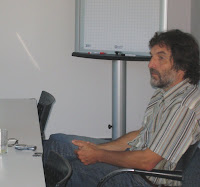In my digital systems design class we have used the eZ430-F2013 development kits – they are cheap (about 20 €) and most students get it working 🙂
I have seen TI has a new development kit which is really interesting: „eZ430-Chronos Wireless Watch Development Tool“ – Could be an useful basis for wearable computing projects – perhaps we should get them for the class on pervasive computing next term?
The TI commercial is on youtube:
http://www.youtube.com/watch?v=LDJIBydJvoM
Some years back IBM had a Linux watch as research platform. Gábor Blaskó published some concepts and protoytpes on how to interact with a watch computer, e.g. with strokes [1] or with a string [2].
[1] Gábor Blaskó and Steven Feiner. An Interaction System for Watch Computers Using Tactile Guidance and Bidirectional Segmented Strokes. Proc. 8th IEEE International Symposium on Wearable Computers (ISWC 2004), Arlington, VA, USA, 31 October – 3 November, 2004. pp.120-123.
[2] Gábor Blaskó, Chandra Narayanaswami, Steven Feiner. Prototyping Retractable String-Based Interaction Techniques for Dual-Display Mobile Devices. Proc. ACM Conference on Human Factors in Computing Systems (CHI 2006), Montreal, Québec, Canada, 22 – 27 April, 2006. pp.369-372.


 The technical solutions were very different and ranged from a dismantled keyboard to a system using a micro-controller, from a two-way mirror with display behind to direction detection in front of an advert. Even though the prototypes were fairly simple most of them showed impressively how much of an idea a functional prototype can transport.
The technical solutions were very different and ranged from a dismantled keyboard to a system using a micro-controller, from a two-way mirror with display behind to direction detection in front of an advert. Even though the prototypes were fairly simple most of them showed impressively how much of an idea a functional prototype can transport.
